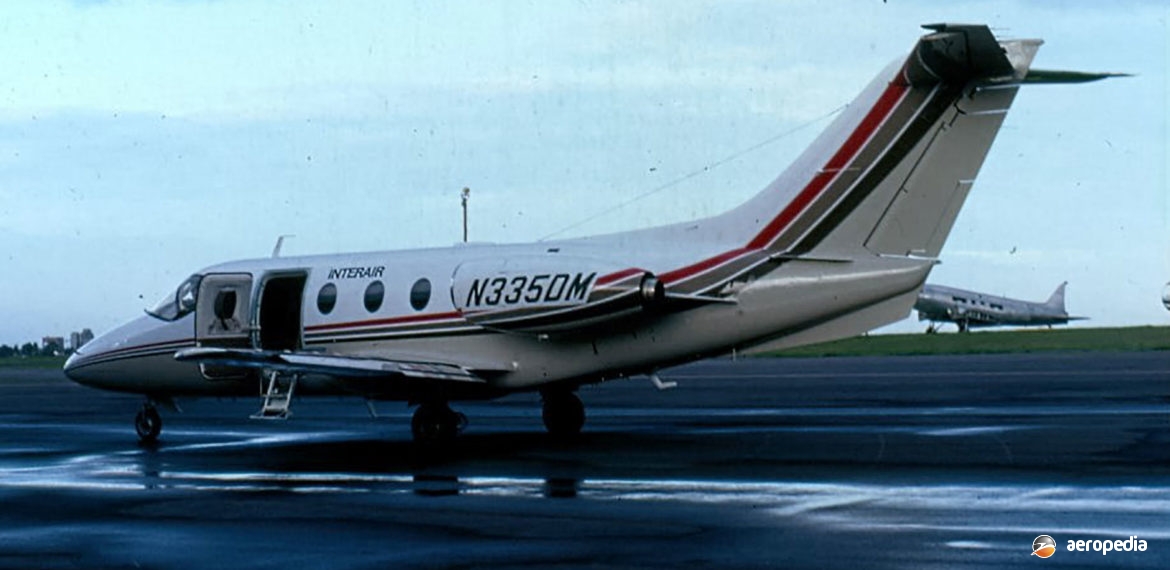Photograph:
Mitsubishi MU-300 Diamond 1A N335DM (c/n A0488A) at Essendon, VIC in July 1983 prior to becoming VH-JEP (Michael Madden)
Country of origin:
Japan
Description:
Business and executive jet
Power Plant:
Two 2,500 lbst Pratt & Whitney JT-15D-4D turbofans
Specifications:
- Wingspan: 13.23 m (43 ft 5 in)
- Length: 14.73 m (48 ft 4 in)
- Height: 4.19 m (13 ft 9 in)
- Wing area: 22.43 m² (241.4 sq ft)
- Max operating speed: 805 km/h (500 mph)
- Normal cruising speed at 11,887 m (39,000 ft): 741 km/h (460 mph)
- Service ceiling: 12,497 m (41,000 ft)
- Max rate of climb: 930 m/min (3,050 ft/min)
- Rate of climb on one engine: 232 m/min (761 ft/min)
- Max operating altitude: 12,497 m (41,000 ft)
- Time to 11,887 m (39,000 ft) at max take-off weight: 36 mins
- Max range with 4 passengers at long-range cruise: 2,797 km (1,738 miles)
- Balanced field length: 1,174 m (3,850 ft)
- Landing distance: 1,402 m (4,600 ft)
- Empty weight: 4,087 kg (9,010 lb)
- Loaded weight: 6,636 kg (14,630 lb)
- Max landing weight: 5,988 kg (13,200 lb)
- Max payload: 780 kg (1,720 lb)
- Max fuel: 1,932 kg (4,260 lb)
- Payload with max fuel: 458 kg (1,010 lb)
History:
Following the success of the MU-2 series, Mitsubishi in 1977 embarked on the design of a new business jet known as the MU-300, this being a conventional low-wing aircraft with a T-tail powered by two Pratt & Whitney JT-15D turbofans mounted on the rear fuselage. It became known as the Diamond and had seating capacity in the cabin for eight passengers and a crew of two. It had a toilet at the rear and room for baggage. Initial testing of the two prototypes (JA-8001 and JA-8002) took place in Japan and these aircraft were subsequently taken to San Angelo in Texas, USA to complete the types FAA part 25 certification.
Type certification was obtained on 6 November 1981 and production aircraft were assembled at San Angelo from components produced at Nagoya in Japan. It was produced in two models, the Diamond I, this being the initial production model of which 89 and the two prototypes were completed; and the Model 1A, deliveries of which commenced in January 1984. In October 1983 Mitsubishi announced it was developing the Diamond II, this having the same airframe with 2,900 lbst JT15D-5 turbofans, and eleven were completed. This model differed from the original production series in having up-rated engines with thrust-reversers, and a number of refinements designed to improve balanced field length and cruise performance.
A total of 61 examples of the Diamond was built before production switched to the IA and later the II. By late 1985 some 100 examples had been delivered when Mitsubishi sold the rights to the aircraft to Beechcraft. It became known as the Beechjet 400, later becoming known as the Raytheon Beechjet 400, and later again the Hawker 400. In 1984 Interair of Melbourne, VIC imported a Diamond I and it became VH-JEP (c/n A0488A – ex N335DM). It was modified to IA standard before it was sold overseas in 1986, again becoming N335DM. It later became PT-LNN before being written off in 1996.

